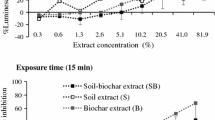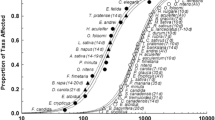Abstract
Previously we have demonstrated the rapid screening potential of a newly developed solid-phase microalgal bioassay with spiked sands. In this paper, we report further comparative results using both PAHs and DDTs spiked sands and field-collected acrisols soils. Toxicity responses obtained from standard higher plant tests with three species of plants (Lolium perenne, Cynodon dactylon and Brassica chinensis) were compared with those obtained from a cocktail of microalgae (Selenastrum capricornutum, Chlorococcum hypnosporum and the indigenous Chlorococcum meneghini). The 5-day seed germination/root elongation tests were not sensitive at all in contrast to the 4-day solid-phase microalgal tests and the 28-day early seedling growth tests in both spiked sands and contaminated soils. Sensitivities of microalgal tests were generally higher than the seedling growth tests in spiked sands. Concerning the assays with contaminated soil, the responses of microalgae and higher plants varied. However, the results demonstrated that microalgae could generally act as effective surrogates to screen xenobiotic compounds at toxic level to higher plants, with the local species C. meneghini especially sensitive to reveal phytotoxic effects. This promising rapid screening solution is possible to be used in accompany with standard seedling growth tests when assessing phytotoxicities of contaminated areas, especially for acrisols soil.



Similar content being viewed by others
References
Adam G, Duncan HJ (2002) Influence of diesel fuel on seed germination. Environ Pollut 120:363–370
Akbar S, Rogers LJ (1985) Effects of DDT on photosynthetic electron flow in Secale species. Phytochemistry 24:2785–2789
Alkio M, Tabuchi TM, Wang X, Colon-Carmona A (2005) Stress responses to polycyclic aromatic hydrocarbons in Arabidopsis include growth inhibition and hypersensitive response-like symptoms. J Exp Bot 56:2983–2994
Allen SE (1989) Chemical analysis of ecological materials. Blackwell Scientific Publications, Oxford, England
American Society for Testing and Materials (1993) Standard practice for algal growth potential testing with Selenastrum capricornutum. Annual book of ASTM standards. ASTM, Philadelphia, Pennsylvania, pp 29–33
Andersen JS (1998) Statisical analysis of biotests - applied to complex polluted samples. Department of Mathematical Modelling. Technical University of Denmark, Lyngby, Denmark
Baun A, Justesen KB, Nyholm N (2002) Algal tests with soil suspensions and elutriates: a comparative evaluation for PAH-contaminated soils. Chemosphere 46:251–258
Bidlan R, Afsar M, Manonmami HK (2004) Bioremediation of HCH-contaminated soil: elimination of inhibitory effects of the insecticide on radish and green gram seed germination. Chemosphere 56:803–811
Brady NC, Weil RR (2002) The nature and properties of soils. Prentice Hall, Upper Saddle River, N.J
Chau KC, Chan WY (2000) Planter soils in Hong Kong: I. Soil properties and characterization. Arboric J 24:59–74
Chu WK (2004) Accumulation and transformation of DDT and PCBs by Phragmites australis and Oryza sativa. L. Hong Kong Baptist University, Hong Kong
Chung MK (2005) Assessment of phytotoxic effects of PAHs and DDTs in solid-phase system using microalgal bioassays. Hong Kong Baptist University, Hong Kong
Chung MK, Hu R, Wong MH, Cheung KC (2006) Comparative toxicity of hydrophobic contaminants to microalgae and higher plants. Ecotoxicology Accepted
Cody TE, Radike MJ, Warshawsky D (1984) The phototoxicity of Benzo(a)pyrene in the green alga Selenastrum capricornutum. Environ Res 35:122–132
deHoogh CJ, Wagenvoort AJ, Jonker F, vanLeerdam JA, Hogenboom AC (2006) HPLC-DAD and Q-TOF MS techniques identify cause of Daphnia biomonitor alarms in the river Meuse. Environ Sci Technol 40:2678–2685
Djomo JE, Dauta A, Ferrier V, Narbonne JF, Monkiedje A, Njine T, Garrigues P (2004) Toxic effects of some major polyaromatic hydrocarbons found in crude oil and aquatic sediments on Scenedesmus subspicatus. Water Res 38:1817–1821
Duxbury CL, Dixon DG, Greenberg BM (1997) Effects of simulated solar radiation on the bioaccumulation of polycyclic aromatic hydrocarbons by the duckweed Lemna gibba. Environ Toxicol Chem 16:1739–1748
Edwards NT (1983) Polycyclic aromatic hydrocarbons (PAH’s) in the terrestrial environment - a review. J Environ Qual 12:427–441
Environment Canada (1992) Biological test method: growth inhibition test using freshwater alga Selenastrum capricornutum. Environment Canada, Ottawa, Ontario
Environmental Science and Technology (2006) Bringing back a killer pesticides. Retrieved October 26, 2006, from Environmental Science and Technology Web site: http://pubs.acs.org/subscribe/journals/esthagw/2006/oct/policy/nl_pesticide.html
Gao YZ, Zhu LH (2004) Plant uptake, accumulation and translocation of phenanthrene and pyrene in soils. Chemosphere 55:1169–1178
Gaur JP (1988) Toxicity of some oil constituents to Selenastrum capricornutum. Acta Hydrochim Hydrobiol 16:617–620
Hammel W, Steubing L, Debus R (1998) Assessment of the ecotoxic potential of soil contaminants by using a soil-algae test. Ecotoxicol Environ Saf 40:173–176
Harkey GA, Landrum PF, Klaine SJ (1994) Comparison of whole-sediment, elutriate and pore-water exposures for use in assessing sediment-associated organic contaminants in bioassays. Environ Toxicol Chem 29:537–545
Henner P, Schiavon M, Druelle V, Lichtfouse E (1999) Phytotoxicity of ancient gaswork soils. Effect of polycyclic aromatic hydrocarbons (PAHs) on plant germination. Org Geochem 30:963–969
Hewitt EJ (1966) Sand and water culture methods used in the study of plant nutrition. Technical communication. Agricultural Bureaux, Farnham Royal, Commonwealth
Hsieh YP, Tomson MB, Ward CH (1980) Toxicity of water-soluble extracts of No. 2 fuel oil to the freshwater alga Selenastrum capricornutum. Dev Ind Microbiol 21:401–409
Huang XD, Dixon DG, Greenberg BM (1993) Impacts of UV radiation and photomodification on the toxicity of PAHs to the higher plant Limna gibba (duckweed). Environ Toxicol Chem 12:1067–1077
Jim CY (2001) Ecological and landscape rehabilitation of a quarry site in Hong Kong. Restor Ecol 9:85–94
Keddy CJ, Greene JC, Bonnell MA (1995) Review of whole-organism bioassays: soil, freshwater sediment, and freshwater assessment in Canada. Ecotoxicol Environ Saf 30:221–251
Kong KY, Cheung KC, Wong CK, Wong MH (2005) The residual dynamic of polycyclic aromatic hydrocarbons and organochlorine pesticides in fishponds of the Pearl River delta, South China. Water Res 39:1831–1843
Liu GQ, Zhang G, Li J, Li KC, Guo LL, Liu X, Chi JS, Peng XZ, Qi SH (2005) Over one hundred year sedimentary record of polycyclic aromatic hydrocarbons in the Pearl River Estuary, South China. Huan Jing Ke Xue 26:141–145
Lower WR, Sutton WW (1987) Chlorphyta assay using soil as sample material: interim procedure. U.S. Environmental Protection Agency, Las Vegas, NV
Maila MP, Cloete TE (2002) Germination of Lepidium sativum as a method to evaluate polycyclic aromatic hydrocarbons (PAHs) removal from contaminated soil. Int Biodeterior Biodegradation 50:107–113
Maliszewska-Kordybach B, Smreczak B (2000) Ecotoxicological activity of soils with polluted with polycyclic aromatic hydrocarbons (PAHs) - effect on plants. Environ Technol 21:1099–1110
Marchiol L, Mondini C, Leita L, Zerbi G (1999) Effects of municipal waste leachate on seed germination in soil–compost mixtures. Restor Ecol 7:155–161
Megharaj M, Kantachote D, Singleton I, Naidu R (2000) Effects of long-term contamination of DDT on soil microflora with special reference to soil algae and algal transformation of DDT. Environ Pollut 109:35–42
Meier JR, Chang LW, Jacobs S, Torsella J, Meckes MC, Smith MK (1997) Use of plant and earthworm bioassays to evaluate remediation of soil from a site contaminated with polychlorinated biphenyls. Environ Toxicol Chem 16:928–938
Metting FB (1994) Algae and cyanobacteria. In: Weaver RW, Angle S, Bottomley P (eds) Methods of soil analysis. Part 2 microbiological and biochemical properties. Soil Science Society of America, Madison, Wisconsin, pp 427–458
Mitchell RL, Burchett MD, Pulkownik A, McCluskey L (1988) Effects of environmentally hazardous chemicals on the emergence and early life stage growth of selected Australian plants. Plant Soil 112:195–199
Mostafa FIY, Helling CS (2002) Impact of four pesticides on the growth and metabolic activities of two photosynthetic algae. J Environ Sci Health Part B Pestic Food Contam Agric Wastes 37:417–444
Muralikrishna PVG, Venkateswarlu K (1984) Effect of insecticides on soil algal population. Bull Environ Contam Toxicol 33:241–245
Norberg King TJ (1993) A linear interpolation method for sublethal toxicity: the inhibition concentration (ICp) approach. National Effluent Toxicity Assessment Center Technical Report, U.S. Environmental Protection Agency, Duluth, MN, p 39
Oliver MA (1997) Soil and human health: a review. Eur J Soil Sci 48:573–592
Organization for Economic Cooperation, Development (2002) Proposal for updating guideline 201: freshwater alga and cyanobacteria, growth inhibition test. OECD guideline for testing of chemicals, Paris, France
Samson G, Popovic R (1988) Use of algal fluorescence for determination of phytotoxicity of heavy metals and pesticides as environmental pollutants. Ecotoxicol Environ Saf 16:272–278
Seguin F, Leboulanger C, Druart JC, Berard A (2001) Effects of atrazine and nicosulfuron on phytoplankton in systems of increasing complexity. Arch Environ Contam Toxicol 40:198–208
Sverdrup LE, Krogh PH, Nielsen T, Kjaer C, Stenersen J (2003) Toxicity of eight polycyclic aromatic compounds to red clover (Trifolium pratense), ryegrass (Lolium perenne), and mustard (Sinapsis alba). Chemosphere 53:993–1003
Swift M, Bignell D (2002) Standard methods for assessment of soil biodiversity and land use practice. International Centre for Research in Agroforestry, Southeast Asian Regional Research Programme, Bogor, Indonesia
Tam NFY, Tiquia S (1994) Assessing toxicity of spent pig litter using a seed germination technique. Resour Conserv Recycl 11:261–274
U.S. Environmental Protection Agency (1996a) Method 3052: microwave assisted acid digestion of siliceous and organically based matrices SW-846. Test methods for evaluating solid wastes. Physical/chemical methods. U.S. Environmental Protection Agency, Washington, DC
U.S. Environmental Protection Agency (1996b) Method 3540C: soxhlet extraction. SW-846. Test methods for evaluating solid wastes. Physical/chemical methods. U.S. Environmental Protection Agency, Washington, DC
U.S. Environmental Protection Agency (1996c) OPPTS 850.4200 seed germination/root elongation toxicity test (Public draft). Ecological effects test guidelines. Office of Prevention, Pesticides and Toxic Substances
U.S. Environmental Protection Agency (1996d) OPPTS 850.5400 algal toxicity, tier I and II (Public draft). Ecological effects test guidelines. Office of Prevention, Pesticides and Toxic Substances
Walsh GE, Weber DE, Simon T, Brashers LK (1991) Toxicity tests of effluents with marsh plants in water and sediment. Environ Toxicol Chem 10:517–525
Zbigniew T (1987) The effects of crude and fuel oils on the growth, chlorophyll a content and dry matter production of a green alga Scenedesmus quadricauda (Turp.) bréb. Environ Pollut 47:9–24
Zucconi F, Pera A, Forte M, de Bertoldi M (1981) Evaluating toxicity of immature compost. Biocycle 22:54–57
Acknowledgments
The authors acknowledge the financial support from the Strategic Research Fund from the Science Faculty, HKBU and technical assistance from Mr. W.C. Li. This study was also supported by the Area of Excellence (AoE) Scheme under the University Grants Committee of the Hong Kong Special Administrative Region (CITYU/AoE/0304/02).
Author information
Authors and Affiliations
Corresponding author
Rights and permissions
About this article
Cite this article
Chung, M.K., Hu, R., Cheung, K.C. et al. Screening of PAHs and DDTs in sand and acrisols soil by a rapid solid-phase microalgal bioassay. Ecotoxicology 16, 429–438 (2007). https://doi.org/10.1007/s10646-007-0146-0
Received:
Accepted:
Published:
Issue Date:
DOI: https://doi.org/10.1007/s10646-007-0146-0




